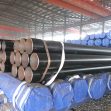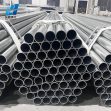How to choose an appropriate heating solution for glass facade buildings
Modern curtain wall design interprets that people tend towards an increasing preference for natural light inside the building. In that regard, glass curtain wall facade manifests itself in the form of floor-to-ceiling glass windows to create a sense of openness and space.

For most of modern high-rise buildings, glass curtain wall is often chosen as a superb building system to utilize much more natural light, reduce energy consumption, harness the solar comfort of the sun and insulate the occupants from noise pollution outside. Furthermore, clean glass lines are also considered aesthetically pleasing as well as a crucial consideration for Architectural Technologists. However, glass is notoriously poor at heat retention, and consequently buildings that are made up of glazed facades can experience high levels of heat loss so as to cause a big warming challenge inside buildings. Additionally, glazed facades are extremely vulnerable to condensation build up. The principle cause of condensation on the inside of glazed facades is high internal humidity levels, coupled with low outside temperatures. In order to maintain the aesthetic desired and prevent condensation and heat loss, the heating and ventilation in the areas needs to be thoroughly considered.
When selecting a facade heating system, what matters is the purpose of the facade heater. Specifically speaking, the heating solution can be designed to provide effective space heating, mitigate heat loss, eliminate condensation, cooling, ventilation and even be used for a combination of all of them. The intention of use will affect the preferred solution and will need to be considered early in the design stage of curtain wall buildings. In most cases, trench heating is considered an ideal facade heating system due to its versatility. Whether it is the range of depths, widths and lengths, the option of grilles, there are numerous trench solutions available. A further advantage of trench heating is that it is a ‘hidden’ solution. That is to say, it doesn’t take up wall space and can therefore be easily installed in front of floor-to-ceiling glazing, without impacting the aesthetic design. In recent years, it is possible for trench heating to not only heat, and also have the additional function of ventilating and sometimes even cooling. For example, trench radiators can now be used to introduce fresh air by a direct connection to the outside, rather than using a separate ventilation system.
In addition, free-standing radiators can also be easily installed at the very end of a project, and can even meet Low Surface Temperature (LST) requirements. However, whilst perimeter heating is less visually obtrusive than other forms of heating, this system still takes up valuable floor space. For lettable spaces this is incredibly important, as the more space required for heating and ventilation, the less available space to let. Dong Peng Bo Da Steel Pipe Group is a famous steel pipe manufacturer in China. We are committed to producing various types of steel products for your choice in your building project in future. Our products are all designed for the fast and easy installation of curtain walls. Contact us if you have any need in your project.
Tel: +86 18202256900 Email: steel@fwssteel.com










